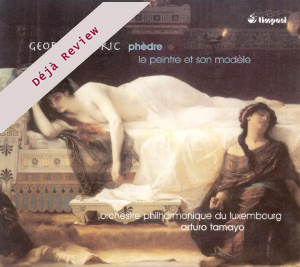
Déjà Review: this review was first published in November 2005 and the recording is still available.
Georges Auric (1899-1963)
Phèdre – ballet (1950)
Le Peintre et son modèle (1949)
Orchestre Philharmonique du Luxembourg/Arturo Tamayo
rec. 2005, Conservatoire, Luxembourg
Timpani 1C1090 [55]
Martin Kahane’s notes pay Auric the tribute of giving us no biographical background on Auric except his involvement in these two ballet scores. It is as if we already know that he was born in Lodève, Hérault in France. A pupil of D’Indy he was at first strongly influenced by Satie. As his individuality grew so he became recognised alongside Durey and Honegger as part of Les Six. We know Auric now because of his film music of which there are collections on both Chandos and Marco Polo. In fact in addition there are fourteen ballets written between 1923 and 1952 as well as some chamber music, songs, piano solos and a clutch of orchestral works.
Across the fifteen movements of the music for the Phèdre ballet Auric proves himself an adherent of a stern and gaunt tonality at times like Barber’s Medea ballet music. There is much that is thunderously emphatic with the message hammered home with tragic intensity as for example in the Danse Funèbre which is more march than dance. The boiling euphoric tension of this music passingly recalls that of Igor Markevitch although Auric always manages to find a more yielding humane accent. His music is also softened by his evident admiration for Ravel’s methods. There is also a Bliss-like abandon about some of the more lively writing as in Danse de joie. The tragic element gripes and shudders especially in the Despair and Fury of Theseus and the Death of Phèdre but even in that last scene Auric writes much that is tender, gentle and imbued with consolation.
Le Peintre et son Modèle is another ballet written one year before Phèdre. This is much shorter and has only seven scenes. Understandably the score is in much the same language as Phèdre except that the jagged tragic element is not as evident. Other moods are in play here including the waltz, an absurdist agenda (like something from Prokofiev’s Love of Three Oranges) and a glittering and starry enchantment in the last movement; contentedly magical writing.
Revelatory experiences here with Auric presented in a new light. Lovely music bound to please those already enthralled by Markevitch, Stravinsky and Bliss.
Rob Barnett
Buying this recording via a link below generates revenue for MWI, which helps the site remain free



















